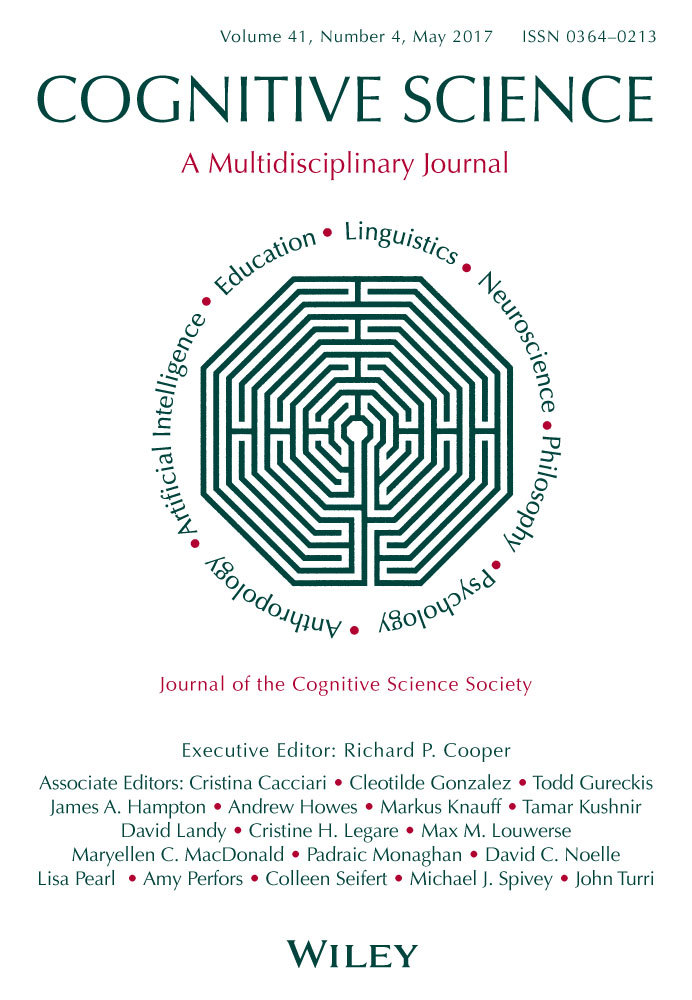Arranging Objects in Space: Measuring Task-Relevant Organizational Behaviors During Goal Pursuit
Abstract
Human behavior unfolds primarily in built environments, where the arrangement of objects is a result of ongoing human decisions and actions, yet these organizational decisions have received limited experimental study. In two experiments, we introduce a novel paradigm designed to explore how individuals organize task-relevant objects in space. Participants completed goals by locating and accessing sequences of objects in a computer-based task, and they were free to rearrange the positions of objects at any time. We measure a variety of organization changes and evaluate how these measures relate to individual differences in performance. In Experiment 1, we show that with weak structure in task demands, changes in object positions that arise through performance of the task lead to improved order, characterized predominantly by a centralization of frequently used items and a peripheralization of infrequently used objects. In Experiment 2, with increased task structure, we observe more refined organizational tendencies, with selective contraction and clustering of interrelated task-relevant objects. We further demonstrate that these more selective organization behaviors are reliably associated with individual differences in task performance. Collectively, these two studies reveal properties of space and of task demands that support and facilitate effective organization of the environment in support of ongoing behavior.
1 Introduction
The reasonable man adapts himself to the world: the unreasonable one persists in trying to adapt the world to himself. Therefore all progress depends on the unreasonable man.
—George Bernard Shaw
By the time modern humans (Homo sapiens) appeared, roughly 200,000 years ago, basic tools had been in use for over 2 million years. By 50,000 years ago, human artifacts had proliferated to include various classes of blades, composite tools, specialized equipment for fishing and mining, and symbolic and decorative items such as beads, pigments, and incised ornaments (McBrearty & Brooks, 2000). In the years since, the number and diversity of objects in our lives have increased exponentially (Kurzweil, 2005)—a hallmark of human distinction within the animal kingdom. Today, a brief survey of a typical home will reveal thousands of individual objects of myriad classes—cutlery, bowls, and kitchen appliances; books, magazines, and loose paper; TVs, computers, and phones; pens, scissors, and tape; couches, rugs, and bookcases; soap, toothbrushes, and combs; posters, paintings, and photographs; shirts, towels, and shoes—a nearly endless retinue.
With the exception of purely symbolic or figurative items (trinkets, paintings, etc.), every one of these objects has potential uses during routine action. Indeed, the sequential access and manipulation of objects forms the backbone of naturalistic behavior. Consequently, the relative ease of locating and accessing different objects in the world will influence, minimally, the effort required to complete a given goal. More realistically, given our tendency to plan behaviors, the relative accessibility of various objects in the world is likely to influence the decision process itself. Of course, given that humans do not possess perfect or complete information about the world, decision making will not be influenced directly by veridical access costs, but rather by a combination of visibility and what the individual knows a priori about accessibility.
Visibility is governed by factors such as occlusion, size and proximity, and salience (the perceptual “distinction” of a stimulus in the visual field, influenced by low-level perceptual features like color or shape; e.g., Itti & Koch, 2000). Known accessibility, in contrast, is internally derived from memory or context-driven expectations, and consequently it is less affected by perceptual salience—including even objects that are entirely outside the visual field. Notably, while an object detected by virtue of its visibility or salience will necessarily provide an exact position, known accessibility may indicate object presence with arbitrary spatial certainty—for instance, that your keys are on the bedside table next to the book, but that your phone is simply “somewhere in the living room.” The predicted effort required to access an object, then, can include both a stable cost to access the target region, plus a variable cost to search within that region. Together, visibility and known accessibility specify the collection of actions that are available to the agent, as well as the estimated cost for sequences of such actions. Behavioral decisions, then, can be arrived at through tradeoffs between possibility, expected cost, and expected reward or desirability (Cisek, 2007; Cisek & Kalaska, 2010; Kirsh, 1995).1
Given the importance of object accessibility in shaping behavior, it becomes relevant to evaluate the factors that determine accessibility. A surface level of explanation notes simply that objects occupy space, and do so exclusively—no two objects can occupy the same space.2 Consequently, objects must either be spread throughout space or stacked together. Trivially, where objects are farther away, they are less accessible, and where they are occluded or crowded, they are less visible. These differences in access and visibility can have substantial influences on the manner in which a task is undertaken—particularly with respect to the balance between external action/exploration and internal cognitive processing. For instance, when objects are widely distributed so that head movements are required to view them, participants show greater reliance on memory as an internal support to offset embodied exploration (Ballard, Hayhoe, & Pelz, 1995; Solman & Kingstone, 2014; for related work, see also Ballard, Hayhoe, Pook, & Rao, 1997; Gray & Fu, 2004; Gray, Sims, Fu, & Schoelles, 2006; Risko, Medimorec, Chisholm, & Kingstone, 2014; Solman & Smilek, 2012). Since differences in accessibility can have pronounced effects on task strategies, and given that the arrangement of objects trivially influences both visibility and accessibility, we ought then to ask: How does that arrangement come to be? Restricting our consideration to interior spaces (i.e., those protected from the elements), it is clear that objects must come to be arranged through the actions of an agent—either deliberately or incidentally. As Kirsh (1995) notes, “Space is a resource that must be managed, much like time, memory, and energy,” and we might refine this point to say that space is a resource that must be managed jointly with time, memory, and energy.
With these observations in hand, we have the makings of an ongoing behavioral loop. In its most reduced form: space biases action ⟷ action modifies space. Arguably, this simply-stated dynamic underlies the bulk of routine naturalistic behavior, yet empirical study of this dynamic is extremely limited. In ecology, animals having significant impacts on the environment are identified as “ecosystem engineers” (e.g., Jones, Lawton & Shachak, 1994, 1997)—but none approach the magnitude and diversity of human organizational behaviors. Some notable efforts to explore human organization have emerged in theoretical and observational research. Analyzing videos of naturalistic human behavior, Kirsh (1995) argues that organization is used to reduce either the actual (physical) or perceived degrees of freedom in a task, so that cognitive burdens associated with the task can be “offloaded,” and goal completion can proceed in a more reflexive, environment-driven fashion (see also Kirsh, 1996, 2001). Likewise, the role of environment “stabilization”—actions that serve to preserve environmental conditions that facilitate desirable behaviors—has been discussed in the context of robotics and artificial intelligence (Hammond, Coverse, & Grass, 1995). Indeed, the production and maintenance of constraints in the world—using specific material organizations to exploit gradients of free energy—has been suggested as forming the basis of all life (Kauffman, 2000).
To date, empirical work has largely focused on so-called epistemic actions—changes to the environment (or the body's relation to the environment) that facilitate information-seeking or cognitive processes (Kirsh & Maglio, 1994). For example, when tallying the value of a collection of coins, individuals will cluster coins by type in order to facilitate the counting process (Neth & Payne, 2011), when generating words from letter tiles, individuals produce more solutions when they are able to manipulate the tiles (Maglio, Matlock, Raphaely, Chernicky, & Kirsh, 1999), when reading rotated texts, individuals will rotate their heads (Risko et al., 2014), and when searching for interlocking configurations of shapes, individuals will typically rotate the shapes in space and make a visual comparison rather than performing a mental rotation (Kirsh & Maglio, 1994; Maglio & Kirsh, 1999). Across a range of tasks, the capacity to interact with the world has been shown to yield advantages in learning and problem solving (Antle, 2013; Guthrie, Vallée-Tourangeau, Vallée-Tourangeau, & Howard, 2015; Manches & O'Malley, 2012; Martin & Schwartz, 2005). These studies of epistemic action offer insight into how the environment may be organized to facilitate cognition. In contrast, empirical work has generally neglected the question of how organization supports action.
To address this gap in the scientific literature, we developed a laboratory task that gives participants (a) control over the environment and (b) some reason or motivation to exert control (e.g., to reduce physical effort). Subordinate to these basic requirements, the task should also offer meaningful freedom as to how it can be performed, but sufficient structure and constraint to be interpretable, and it should enable the measurement of global organizational characteristics (How are objects arranged relative to each other and to the agent?), as well as local organizational decisions (When and where are individual objects moved by the agent?).
The purpose of the current work is to introduce a novel, lab-based task for controlled and quantifiable study of organizational behaviors, with the goal of balancing the competing needs for reductive simplicity and naturalistic or ecological validity. Our aim is to reduce the process of naturalistic goal pursuit to a simplified, abstract case where both measurement and control are tractable. As a preliminary effort, we use this task to examine some relatively simple organizational behaviors, as well as to demonstrate how individual differences in these behaviors influence task performance. In particular, we ask the following questions: (a) How do the global relational properties of a collection of items change as those items are used over time for goal pursuit? (b) Given that a used object must be “in-hand,” and that an object in-hand must ultimately be replaced in the world, how are these replacement decisions made? and (c) How do individual differences in organizational behaviors relate to differences in performance?
1.1 Task design
- Sequential Access: Behavioral goals involve the sequential use of objects.3 The specific objects and sequences needed for a given goal are flexible (equifinality) but constrained—there is more than one way to skin a cat, but far more ways that will not.
- Task Transparency: The ways in which objects can be used in sequence to obtain a goal are known / transparent to the actor (that is, we are at present largely interested in routine or familiar behaviors rather than in the prerequisite learning of how different objects can be used together).
- Spatial Dependency: Objects are distributed in space. Distant objects are both more difficult to see and more difficult to access relative to proximal objects.
- In-Hand Use: The use of an object—and consequently any progress in completing goals—requires that the object be physically accessed in space, not merely located visually. An object must be “inhand” to be used, and once inhand must be deliberately replaced in the world.
To meet these requirements, our approach was to dissociate “action space” from “goal space,” such that agent movement and interaction with objects occurred in the action space, whereas the current goal, state of progress toward that goal, and set of possible action sequences to make further progress were specified in the goal space. The general properties of these spaces are described below, and a video example can be viewed at <vimeo.com/119885364>. A full technical description is provided in the Methods section.
1.1.1 Action space
The action space was presented as a circular area that comprised three concentric rings (Fig. 1, left side). The innermost circle represented the agent's body, the middle ring represented the “reach space,” and the outermost ring (comprising the remainder of the display) represented visibility. To accentuate distance, item sizes were scaled as distance from the center increased, using a hyperbolic mapping, so that items could grow arbitrarily small as the agent moved away, but would always remain visible on the border of the space. This approach reflects an “infinite plane” world—where one can move arbitrarily far from an object, but it will remain on the horizon (albeit arbitrarily small). We chose this interface to allow for a large-scale space necessitating movement, but avoiding the disorientation associated with simply panning a window over a large image (Solman, Cheyne, & Smilek, 2012).
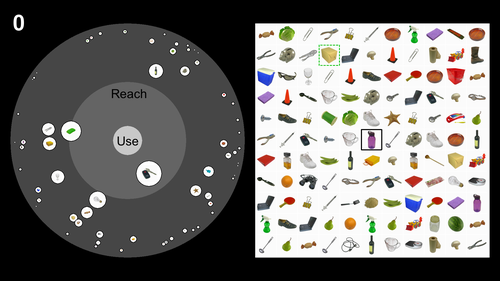
To move through the environment, agents used a click–drag interface, moving themselves relative to the items in the space, thereby changing which items were in reach and which were merely visible. Items within the reach area could be grabbed and moved relative to each other, including overlap and occlusion, or dragged to other regions of space. In order to use an item, agents would have to move themselves in space to bring the item within reach, then grab the item and bring it onto the central “body” region. With the exception of these use events, the body region was given “substance,” so that items could not be walked over, but had to be moved out of the way. This was implemented through collision detection during movement—that is, it was not necessary for the agent to deliberately grab and move each obstructing item, rather the “cost” for moving across items was simply the potential disorder left in the agent's wake.
These decisions captured both the Spatial Dependency and the In-Hand Use properties discussed above. Items are distributed in space, with distant items both more difficult to see and more difficult to access. In order to use an item, the agent has to move through space to bring the item in reach, then grab the item and bring it to the body. Once it has been used, the agent must choose where to put it down again—either deliberately, or by simply dropping it on the “body” (whereupon the body collision would push it outward).
1.1.2 Goal space
The goal space was instantiated as a grid of items (Fig. 1, right side). One cell of the grid was highlighted to represent the agent's current state. Accessing the object on any of that cell's cardinal neighbors would move the current state onto that neighboring cell. This approach imposed the sole mandatory constraint on grid construction—that no cell could have two neighbors of the same type. Goals were presented as target states in the grid, and agents were rewarded once they had moved their current state onto a target state. Grid traversal proceeded through sequential access of neighboring items, affording a great diversity of possible paths, all of which could be simply and transparently discerned by the agent. This instantiation then satisfies both Sequential Access and Task Transparency requirements.
2 Experiment 1
In Experiment 1, we collected performance data for a basic version of the task described above. In particular, the goal grid was generated randomly, so that individual items had (in principle) uniform usage potential, and no overt clustering or specific association rules applied to pairs of items. In other words, we used the core task specifications without any additional constraints. We evaluated three key questions: (a) how does the relational configuration of the action space change over time—and does it come to reflect the structure of the goal space? (b) How can these changes be traced to individual item moves—once the agent has grabbed an item, what do they do with it? and (c) Do differences in these organizational metrics predict differences in performance?
2.1 Methods
2.1.1 Participants
Here 53 undergraduate students (42 female, 11 male) from the University of British Columbia participated for course credit and a small performance-contingent food reward (pop, chips, or chocolate, of the participant's choosing). All participants reported normal or corrected-to-normal visual acuity, and normal color vision. Two participants (1 female, 1 male) completed fewer than 10 goals and were excluded from the analyses.
2.1.2 Displays

Maximum item size was 100 pixels at da = 0.0, and minimum item size was held at 2 pixels, so that items arbitrarily far were still represented in the space. In Fig. 2, scaling with coordinate space distance d* is shown in terms of the proportion of the maximal value (i.e., Item Size = proportion of max item size, Onscreen Distance = proportion of Action Space radius).
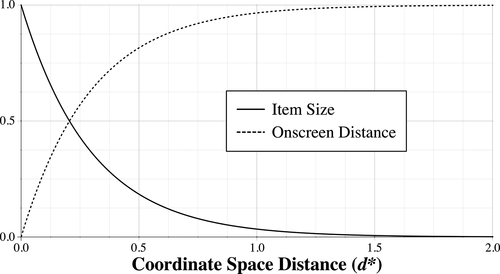
The goal space was presented on the left side of the display and consisted of an 11 × 11 grid populated (non-uniquely) with the items in the action space. A single grid was generated for each participant, with the sole constraints that (a) no two neighbors of a given cell could have the same identity, and (b) no cell could have a neighbor matching its own identity. Within the goal space, the participant's current state was highlighted with a black box, and the target state was highlighted with a green box. In the example in Fig. 1, the current state is a purple water bottle, and its neighbors determine the available actions: a white shoe (above), a ladle (right), an orange bag (down), and a measuring cup (left). If the participant were to locate the white shoe in the action space and drag it onto the “body” region (using it), then the current state would move upwards onto the white shoe, and the new neighbors would determine the available actions: piggy bank (up), starfish (right), purple water bottle (down), and cabbage (left).
2.1.3 Procedure
Each participant was given a random set of 64 items, and a random goal space populated with these items, and began the task with a random initial configuration of items in the action space. A single target was presented in the goal space at any one time, and a new target was selected whenever the participant reached the previous target. One point was awarded for each target obtained, and participants were instructed to maximize their score over the allotted time of ~45 min. At the end of the experiment, points could be exchanged for small food rewards (chocolate, chips, pop). All other aspects of task performance were at the participant's discretion. They were free to move through the space, move objects in the space, and take whatever path they wished through the goal space to reach a given target. Participant actions and the states of the action space and goal space were continuously monitored throughout the experiment.
2.1.4 Apparatus
The experiment was written and executed in Python using the pygame module, and run on an Apple mini, with OS X 10.6.4 and a 2.4 GHz Intel Core 2 Duo processor. The stimulus displays were presented on a 24″ Dell Acer V243H monitor at a resolution of 1,920 × 1,080. Seating distance was not rigidly controlled, but it was approximately 60 cm.
2.2 Results
The three broad questions of interest concerned global organizational properties, local item replacement behaviors, and individual differences in performance. We first evaluate the organization by examining the degree to which global item configurations support task demands, then by evaluating the relation between an individual item's position in the display and the frequency with which that item was used. Subsequently, we evaluate the characteristics of individual item moves throughout the experiment. To assess individual differences, we include performance—measured by the number of goals completed per unit time—as a covariate in all analyses. Our core comparison is to examine the configuration at the beginning and at the end of the experiment, contrasting expected values for the initial randomly generated configuration to those for the final, participant-created configuration. Example configurations at the end of the experiment are presented in Fig. 3. To facilitate the communication of our key results, we present only the essential analyses here. Complete details and statistics for all analyses are provided in the Supplementary Materials.
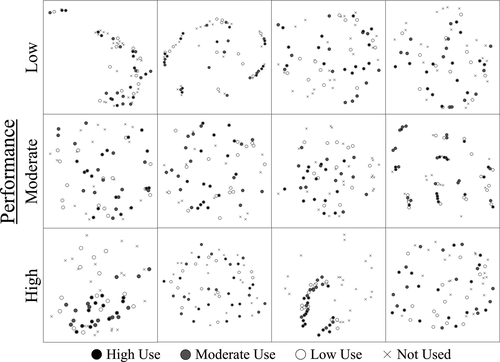
2.2.1 Global organization
Our first analysis examines directly whether or not participant-driven changes to the configuration support task performance. In particular, we calculated the expected item-to-item distance in the environment, given the observed sequence of items used by the individual. Smaller expected distances indicate configurations tuned to the particular sequential demands of the task—so that items frequently used one after another are found closer together in space, minimizing travel time.
Expected distances were related only to performance, decreasing as performance improved, F(1, 49) = 8.35, p < .01, both in the final configuration, r(51) = −.329, p < .05, and, interestingly, in the initial configuration as well, r(51) = −.292, p < .05. Importantly, this result indicates that random biases inherent in the initial configuration of items play a significant role in shaping and improving performance.
2.2.2 Item measures
Having established that participants—at least those performing well in the task—engaged in task-relevant organization at a global level, we next consider this organization at the level of individual items. Item-level measures were evaluated in relation to the frequency with which each item was used during the experiment, contrasting relatively infrequently and frequently used items. We consider three measures: (a) eccentricity—the distance of an item from the center of mass of the configuration, (b) local density of the region around an item, and (c) local use—a distance weighted average of the frequency of use of nearby items. One straightforward form of organization would be to centralize high-use items and peripheralize low-use items. In this case, we would expect that eccentricity should decrease for high-use items relative to low-use items, and that both local density and local use should increase around high-use items as they come to be clustered together in the center. We can further predict that these tendencies should be pronounced for higher performance participants.
We find that organization decisions varied considerably depending on how frequently a given item was used. High- and low-use items, randomly arranged at the outset of the experiment, were organized over time such that high-use items were centralized, while low-use items were pushed to the periphery, F(1, 49) = 21.6, p < .001 (Fig. 4A). Importantly, the emergence of this pattern over time indicates that subjects do not use items more often because they are central, but rather they make items central because they use them. This organizational tendency was observed regardless of performance.

Local density effects dovetailed well with the eccentricity analysis, showing that high- and low-use items are initially undifferentiated, but over time come to be organized in relation to their use. In the case of density, it appears that over time high-use items come to be more densely surrounded by other items than are low-use items, F(1, 49) = 15.7, p < .001 (Fig. 4B). Notably, although this effect is predicted by the eccentricity results, it appears that density shows only increases over time, where eccentricity exhibited a full crossover, indicating that density changes are at least partially distinct from the centralization tendency. As with eccentricity, we see no indication that these organizational tendencies relate to performance.
Local use showed similar results, indicating that the items surrounding high-use items were themselves used more frequently than those surrounding low-use items, F(1, 49) = 41.4, p < .001 (Fig. 4C), indicative of a clustering of high-use items. Importantly, this effect was significantly moderated by performance, F(1, 49) = 13.1, p < .001, with enhanced clustering of high-use items for participants with higher performance.
2.2.3 Item replacement decisions
Our two final measures concern the characteristics of individual item movements, with the aim of exploring how the organizational changes reported above come about during the task. We ask, once an item has been picked up, where is it subsequently put down? Two characteristics of these item placements are considered: (a) change in overlap and (b) change in proximity. Decreases in item overlap would support a strategy of segregating or spreading items apart. Increases in item overlap could indicate a deliberate attempt to increase density, but they could also reflect a generally indiscriminate or careless approach to item replacement decisions. With respect to proximity, deliberate organization should be reflected in items being replaced away from where they were initially retrieved—that is, items will be selected from wherever they happen to be but will often need to be moved somewhere else in order to be deliberately placed within the organization.
Generally, when an item was grabbed, it was close to the agent and with high overlap, and when it was replaced in the display, it was farther, F(1, 49) = 25.1, p < .001, and with lower overlap, F(1, 49) = 298.5, p < .001. These effects depended somewhat on the level of item use. Higher use items tended to be closer to the agent when interacted with relative to lower use items, F(1, 49) = 8.04, p < .01. Higher use items also tended to have less overlap prior to interaction, F(1, 49) = 15.7, p < .001, and increasingly so as performance increased, F(1, 49) = 7.43, p < .01. Although overlap following a move was statistically uniform across item use, we note that higher use items were by definition moved more often—and consequently a greater proportion of moves of high-use items would occur following an earlier overlap-reducing move, and so an average pre-move overlap reduction is to be expected for these items.
2.3 Discussion
We observed clear indicators of organizational behavior, both at global and item-specific levels. Globally, individuals with high performance had item configurations that reduced the expected travel distance between frequently-paired items. Importantly, this effect was present even in the initial item configuration, prior to participant-driven changes, suggesting that task performance was at least partially influenced by chance configurational differences present in the environment.
Considered on an item-by-item basis, organizational tendencies varied depending on the relative frequency of use of different items. Over time, high-use items tended to be found more centrally, while low-use items were pushed to the periphery. Commensurately, local density increased around high-use items, and high-use items tended to be clustered near one another. Although most of these effects were unrelated to individual differences in performance, performance was strongly related to the tendency to cluster high-use items together. Although all subjects showed equivalent centralization of (and increased density around) high-use items, higher performance subjects showed a significantly greater tendency to actually bring these items together in space.
With respect to individual item moves, we find a relatively stereotyped pattern of grabbing items from nearby and replacing them farther away, and of limiting overlap when replacing an item in the display. This wide spacing may improve performance by reducing perceptual clutter, and thereby assisting search and navigation through the display. These effects were moderately influenced by item use, with higher use items generally closer to the agent while being interacted with, and overall exhibiting less overlap—presumably because, having been moved more often, they are more likely to have been replaced in a low-overlap position.
Overall, the results from Experiment 1 demonstrate that robust organizational tendencies emerge when participants are given the freedom to exert control over the task configuration. Interestingly, many of these tendencies showed relatively little relation to performance, suggesting that these kinds of organization may reflect emergent or incidental effects rather than deliberate strategic decisions. This observation suggests a form of task-driven or bottom-up organization, whereby completion of a task under spatial constraints (i.e., of reach and visibility) can produce order in the absence of deliberate planned arrangement behaviors (cf, Agre, 1997). In Experiment 2, we attempt to encourage more deliberate organization by reducing the complexity of the goal space, and thereby introducing more rigid structure into the sequential relations between items.
3 Experiment 2
In Experiment 1, we found preliminary evidence for task-relevant organization during an open-ended goal completion task. This organization, however, was relatively generalized—at its core, characterized by the respective centralization of high-use items and peripheralization of low-use items—and in most cases did not relate to individual differences in performance. A potential reason for these moderate effects stems from a lack of structure in the goal space itself. In Experiment 1, items were randomly placed in the goal space, so that item-item associations were inconsistent and difficult to isolate. Indeed, on average each item was connected to more than six others, and more than 95% of all item-item links occurred only once in the grid. These goal space conditions may have discouraged participants from attempting, or making, strong organizational decisions; the broad partitioning of items based on relative use frequency may have been the only plausible ordering available. With organization and opportunities for organization limited overall, the finding that differences in performance were largely unrelated to differences in organization becomes difficult to interpret.
In Experiment 2, we test this idea by providing a much clearer structure in the goal space. In particular, two distinct subsets from the full collection of items defined the goal space, and these subsets were arranged so that participants had a choice between which subset of items they used for each goal. In this way, the opportunity for organization is improved, as a certain subset of items is clearly more relevant than others. Under these circumstances, we should expect stronger effects of organization, and better differentiation between low- and high-performance subjects.
3.1 Methods
3.1.1 Participants
In this study, 53 undergraduate students (31 female, 22 male) from the University of British Columbia participated for course credit and a small performance-contingent food reward (pop, chips, or chocolate, of the participant's choosing). All participants reported normal or corrected-to-normal visual acuity, and normal color vision.
3.1.2 Items and displays
The items and displays were in most respects identical to those in Experiment 1, with the exception of the goal space. Items were again placed non-uniquely within the goal grid, with the constraints that no two neighbors of a given cell could have the same identity, and no cell could have a neighbor matching its own identity. Additional differences in how the goal space was generated are discussed in the Procedures section below.
3.1.3 Procedure
Each participant was given a random set of 64 items and began the task with a random initial configuration of these items in the action space. In contrast to Experiment 1, the goal space was regenerated after each successful goal completion. Goal completion was structured in “epochs” of 10 goals. For each epoch, two non-overlapping subsets of 12 items each were randomly drawn from the full set of 64 items. At the outset of each goal, the goal grid was regenerated. The left half of the grid was populated with items from one subset, while the right half of the grid was populated with items from the other subset, and the central vertical column was composed of items drawn uniformly from either subset. The current state was placed in the bottom center of the grid, and a target state was placed in both the upper left and upper right corners (Fig. 5). Once one of these goals was obtained, the goal grid and current state would reset, with the assignment of the subsets to left or right halves randomized. After 10 goals, a new epoch would begin, with newly generated item subsets.
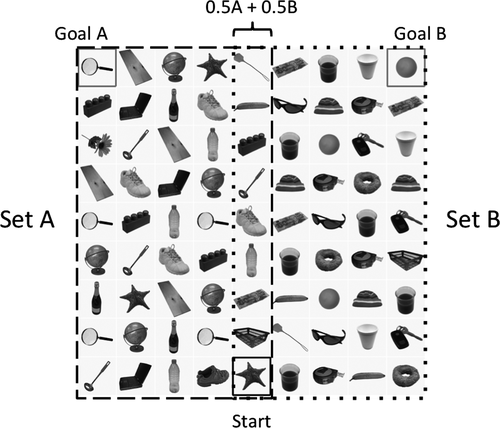
As before, one point was awarded for each target obtained, and participants were instructed to maximize their score over the allotted time of ~45 min. At the end of the experiment, points could be exchanged for small food rewards (chocolate, chips, pop). All other aspects of task performance were at the participant's discretion. They were free to move through the space, move objects in the space, and take whatever path they wished through the goal space to reach a given target. Participant actions and the states of the action space and goal space were continuously monitored throughout the experiment.
3.1.4 Apparatus
The experiment was written and executed in Python using the pygame module, and run on an Apple mini, with OS X 10.6.4 and a 2.4 GHz Intel Core 2 Duo processor. The stimulus displays were presented on a 24″ Dell Acer V243H monitor at a resolution of 1,920 × 1,080. Seating distance was not rigidly controlled but was approximately 60 cm.
3.2 Results
As in Experiment 1, we first evaluate global organization over time and across performance, followed by item-level organizational analyses, and finally an evaluation of individual movement characteristics. For item-level analyses, instead of identifying low- and high-use items, we classify items based on their set membership. Item sets were classified as Chosen or Unchosen on the basis of which set was used most often during the epoch, and the remaining items (not present in either set) were classified as Neutral. To provide a matched comparison across individuals and across performance, we analyzed organizational changes only over the first epoch (i.e., the first 10 goals)—which all participants completed. The initial organization was that at the outset of the experiment, and the final organization was that following completion of the tenth goal. Participant performance was again measured by the number of goals completed per unit time, and this was evaluated across the full experiment (i.e., performance was assessed beyond the first epoch). Example final configurations are presented in Fig. 6.
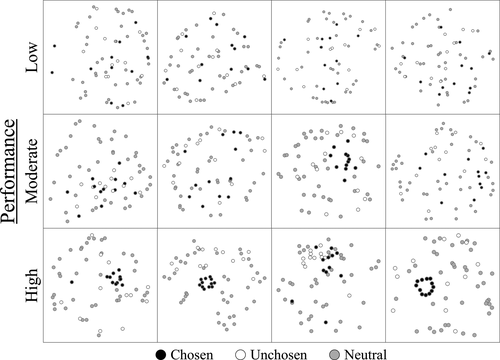
3.2.1 Global organization
Expected distance was computed as in Experiment 1, weighting the influence of distances between particular item pairs by the observed sequence of items used. Expected distances decreased over time, F(1, 51) = 39.1, p < .001, and decreased as performance improved, F(1, 51) = 36.3, p < .001, and these effects also interacted, F(1, 51) = 29.0, p < .001. In contrast to Experiment 1, there was no performance relation in the Initial configuration, but there was a strong negative relation between expected distance and performance in the Final configuration, r(53) = −.661, p < .001. In sum, item configurations were shaped to the particular demand characteristics of the task, and most prominently so by those participants with the greatest performance.
3.2.2 Item measures
Item-level measures were evaluated in relation to the set membership of each item. Item sets were classified as Chosen or Unchosen on the basis of which set was used most often during the epoch, and the remaining items (not present in either set) were classified as Neutral. The item measures from Experiment 1 are mirrored in this case, with some additions and modifications. We evaluated the following: (a) Chosen and Unchosen set areas—quantified by computing the convex hull for each subset of items, (b) item eccentricity, (c) overall local density, (d) local density of Chosen items specifically, and (e) local density of Unchosen items. Task-related organization should be reflected in selective centralization and clustering of items from the Chosen set, leading to reduced eccentricity, reduced area, increased overall local density, increased local density of Chosen items, and decreased local density of Unchosen items.
Over time, Chosen items were brought closer together (occupying smaller areas, F(1, 51) = 9.03, p < .005, Fig. 7), and made more central in the display, F(2, 102) = 13.7, p < .001 (Fig. 8A). Commensurately, the density around Chosen items increased, F(2, 102) = 17.0, p < .001 (Fig. 8B), and in particular the local density of other Chosen items increased, F(2, 102) = 30.6, p < .001 (Fig. 8C). All of these effects were significantly enhanced with increasing Performance—smaller areas: F(1, 51) = 16.5, p < .001; more central items: F(2, 102) = 7.84, p < .001; increased overall density: F(2, 102) = 8.83, p < .001; and increased Chosen item density: F(2, 102) = 25.4, p < .001. Unchosen items showed comparatively modest organization, but were nonetheless more centralized relative to Neutral items, F(1, 51) = 12.2, p < .005 (Fig. 8A), and more clustered over time, F(1, 51) = 9.67, p < .005 (Fig. 8D). Generally, participants arranged the items in the display so that Chosen items are most central, followed by Unchosen items, then by Neutral items.
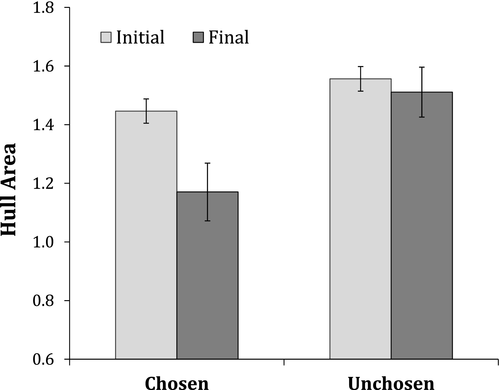
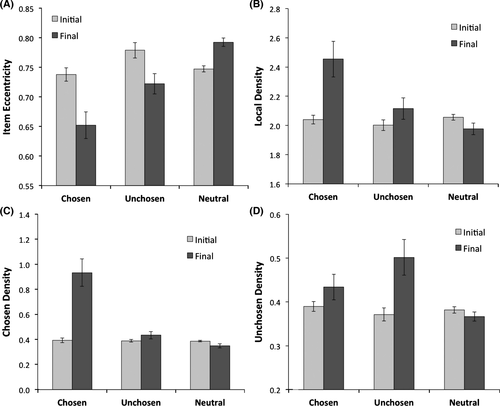
Although we found that the initial global configuration of the items did not have an impact on performance in Experiment 2, the locations of individual items in that pre-organization configuration did have a significant effect on Performance, which demonstrates how fortuitous differences in the unorganized environment can influence subsequent behavioural efficiency. In particular, higher performance subjects were more likely to have an initial configuration with items that would ultimately be Chosen positioned relatively central, and Unchosen items already relatively peripheral, F(1, 51) = 10.3, p < .005. These incidental aspects of the initial configuration may have facilitated the selection of which goal to pursue, as well as providing a scaffold for subsequent organizational behaviors that accentuated these differences. The more central items naturally became the Chosen set, and this incidental pattern was then further reinforced and exaggerated.
3.2.3 Item replacement decisions
We next evaluate the characteristics of individual item moves during the task. As in Experiment 1, we measure two characteristics of these item placements: (a) change in overlap and (b) change in proximity.
Overall, and with minor exceptions, these results mirrored those from Experiment 1. Items were close to the agent and with high overlap when grabbed, and farther from the agent, F(1, 51) = 18.9, p < .001, with reduced overlap, F(1, 51) = 586.2, p < .001, when replaced in the display. Also consistent with the results from Experiment 1, Chosen items tended to have less overlap prior to being moved than either Unchosen items, F(1, 51) = 31.2, p < .001, or Neutral items, F(1, 51) = 27.9, p < .001, and this tendency was enhanced as performance increased, F(2, 102) = 3.45, p < .05. As with high- as compared to low-use items in Experiment 1, this reduction in pre-move overlap likely reflects the increased frequency of Chosen item moves, and consequently the increased likelihood that a given Chosen item had already been moved into a low-overlap position.
3.3 Discussion
With increased structure in the goal space, in Experiment 2, we find a commensurately enriched pattern of organizational behaviors. Displays were arranged over time so that Chosen items were most central, followed by Unchosen items, with unused Neutral items at the periphery. The area occupied by Chosen items contracted, with Chosen items preferentially clustered with other Chosen items, and Unchosen items were likewise preferentially clustered, but without a change in area. All of these effects were significantly amplified as task performance increased. Interestingly, we also observed evidence that incidental arrangements in the initial configuration were related to performance, so that initial configurations already exhibiting some of the above organizational tendencies often lead to increased performance overall.
4 General discussion
In experimental psychology, the prototypical approach is to present a subject with a stimulus, measure the response, and then present a new stimulus. This approach enables an enormous scope of questions to be asked and tested, but it has a necessary blindspot—it limits the ability to investigate how subjects organize the world themselves. In effect, prototypical investigations have engaged a great deal of effort in measuring snapshots of behavior, but we are left with a fragmented picture of the ongoing dynamics of behavior—where the world is both a cause for action and also a product of actions. In the present study, we have taken an initial step toward addressing this issue by focusing on one key aspect of a person's engagement with the world: how he or she organizes behaviorally relevant objects in space. To this end, we have presented a novel task, which we believe provides a suitable arena for testing in this domain, offering a balance between control and measurement on one hand, and freedom of behavior on the other.
Spatial organization behaviors were evaluated in two experiments, which we may retroactively identify as having weak task structure (Experiment 1), and strong task structure (Experiment 2), respectively. We sought to evaluate three aspects of organizational behaviors: (a) whether and how the global relational properties of the space would come to reflect task relevance, (b) the characteristics of item replacement decisions, and (c) how behavioral differences relate to individual differences in performance.
With respect to global relational properties, we find strong evidence for task-relevant organization, even in weak task-structure conditions, broadly characterized as centralizing the most used items and pushing less used items to the periphery. In Experiment 1, there was little further differentiation possible. In Experiment 2, however, set-specific organization was possible, and selective contraction and clustering of specific item subsets relevant to the task was clearly observed.
For individual move characteristics, we found broadly similar patterns across experiments, such that items were typically replaced in the world farther from the agent than they were when they were grabbed, and so that item overlap was reduced following moves. Items used more often tended to be replaced somewhat closer than less frequently used items, and also tended to have less overlap preceding a move—presumably owing to prior overlap-reducing moves.
Few of the behavioral measures in Experiment 1 differentiated individuals who did relatively well or relatively poorly on the task, with the exception of a tendency for higher performance subjects to produce more clustering of frequently used items, and thereby to have reduced expected inter-item distances. In contrast to these limited predictors for performance in Experiment 1, when task structure was increased in Experiment 2, a wealth of behavioral metrics were found to relate to performance differences, including set-specific changes in area, item eccentricity, local density, and clustering. In sum, the results of Experiment 2—in marked contrast to Experiment 1—indicated that wherever a task-relevant organizational behavior was observed, this behavior was amplified for efficient as compared to inefficient subjects. Across both experiments, we see evidence that organization emerges naturally, in some sense imprinting the task structure onto the space. However, only when this task structure is sufficiently robust, do we see clear performance-related differentiation between organizational approaches. The specific properties a task-structure might need are discussed below.
4.1 Task-space complementarity
We have thus far spoken of “task-structure” in only a relatively abstract and general sense. Here we offer some suggestions about how this property might be quantified and operationalized. Of core importance is the degree to which task demands and spatial constraints are complementary. In real environments, spaces are constrained by the configuration of interior walls and the available furnishings, counters, shelves, and so on. These constraints define explicit spatial subdivisions, which are typically asymmetric in both size and access properties (contrast the top shelf of a cupboard with the kitchen counter). Given these inherent subdivisions, we can say that a space affords a partitioning of items that uniformly fills these subdivisions (i.e., an area with twice as much space should contain twice as many objects).4 On the side of task demands, item association is more liberal; although a single item can occupy only one position in space, it may be sequentially associated with an arbitrary number of other objects during behavior. In practice, however, item associations will not be uniform. Rather, certain sets of objects will be consistently related to each other, and only rarely related to other objects (e.g., a knife and cutting board). Indeed, it has long been noted that routine action seems to unfold along hierarchical or quasi-hierarchical lines, so that behavior can be successively decomposed into smaller subtasks (e.g., Botvinick, Niv, & Barto, 2009; Cooper & Shallice, 2006; Lashley, 1951; Miller, Galanter, & Probram, 1960; Norman & Shallice, 1986). These subsets, implicit in the sequence of task demands, define a task-based partitioning of items. In graph analysis, this form of partitioning is referred to as “community”—identifying subsets of nodes with high internal connectivity, but low connectivity between subsets.
Given these two partitions, a space-defined partition and a task-defined partition, we can assess the degree of “fit”—how well can the demand partition be mapped onto the partition afforded by the space? The mapping is, of course, complicated in a number of ways. Task-defined subsets will generally be imperfect, so that items in one subset may sometimes be associated with items in a different subset—and this categorizational fuzziness will itself vary from item to item, so that although a toothbrush is almost exclusively associated with toothpaste, a sheet of paper may be written on, cut with scissors, or folded up to brace a wobbly chair leg. Likewise, there is considerable flexibility in the space-defined partitioning, as items need not be arranged with uniform density—a space twice as large affords twice as many objects, but it does not require twice as many objects.
To see how these ideas work in practice, we apply them to the current experiments. Here, the space-defined constraints are minimal—the action space used was a featureless, unbounded plane. Nonetheless, the scalar properties of reach and item size define an implicit partitioning into regions that can be fully encompassed within the agent's reach from a given position. Task-space complementarity, then, will depend on the extent to which task demands yield subsets of items that can be easily contained inside the agent's reach. To assess how readily task demands yield such subdivisions, we measure the cut sets of sequentially contiguous item sets (i.e., neighboring items in the goal space). Any partition of a graph into two sets of items defines a “cut set”—which is the collection of edges that link the two sets. Community-based partitions are therefore associated with relatively small cut sets, that is, relatively few edges between item subsets. In Fig. 9, we show example goal spaces from Experiments 1 and 2, estimating the community of local 3 × 3 clusters of items by the magnitude of their cut sets. Darker values indicate high community, and lighter values indicate low community. From visual inspection, it is clear that the goal spaces used in Experiment 2 had higher local community than those used in Experiment 1. Commensurately, in Experiment 2, we observed both stronger organizational tendencies, as well as better coupling between organization and performance.
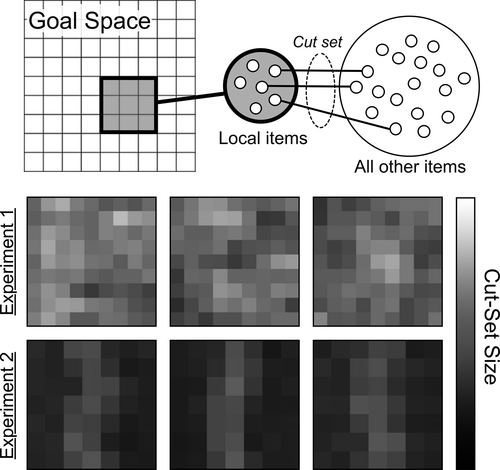
4.2 Optimality
A range of reliable organizational behaviors were observed in the present experiments, and in many instances these behaviors were shown to facilitate task performance. Here we discuss to what extent these organizational tendencies may be viewed as optimal. Note, however, that we do so with the caveat that what follows occurs under a number of simplifying assumptions. To attempt a full analytic solution would be impractical, requiring considerations that include, but are not limited to, tuned parameters for sequence learning rates, perceptual acuity, memory, search strategies, and the interactions between item availability and decision making or the perceived versus actual temporal and physical costs of movement through the space. Nevertheless, if we ignore the many aspects of task performance related to locating items (e.g., if we assume that between explicit memory and perceptual acuity search demands are negligible), then we can ask what optimal configuration might minimize the demands of access.
Most generally, needed items should be brought as close together as possible, but avoiding overlap. However, because an agent must move through space to get from item to item, but cannot move through items without disrupting them, additional constraints are in place. In particular, connected regions of empty space must be available for the agent to travel through, and each item should be accessible from one of these regions (i.e., items should not be out of reach by virtue of other intervening items). These competing tendencies—reducing the distance between items, while maintaining space for the agent—are most generally solved by energy-minimizing closed surfaces (like soap bubbles) that balance the inward “pressure” exerted by minimizing distances with the outward “pressure” of the agent's need to move about.
Two broad classes of solution are expected to emerge as the relative strengths of these forces vary. When the agent's outward “ease-of-movement” force dominates, we expect a single closed circle with the agent on the interior. When the inward “size-of-movement” force dominates, we instead expect a multitude of small circles, with the agent on the exterior. We can further extend the physical analogy to predict when these two conditions are likely to prevail. In particular, if we apply the fundamental pressure–volume–temperature relation, we expect single-surface, interior-agent cases when the space is small (low volume → high pressure), and multiple-surface, exterior-agent cases when the space is large (high volume → low pressure). As a real-world example, compare the modest library in a typical home—with bookshelves arrayed on the walls, to a large public or academic library—where a proliferation of cases fill the space as islands.
How well do the present data mirror these intuitions? Experiment 2 provides the simpler case, with small subsets of relevant items, related sequentially by uniform item-item transition rates. Here, the small number of useful items prescribes a low-volume, single-surface, agent-interior solution. And, indeed, we note that three of the four top performing participants (recall Fig. 6) show precisely this arrangement (as did a number of other participants). The case in Experiment 1 is more complex, with a greater number of items and decidedly non-uniform item-item transition probabilities. Here we find fewer examples of single-surface, agent-interior solutions, although it is noteworthy that where they do occur they are mostly associated with higher performance (Fig. 10).
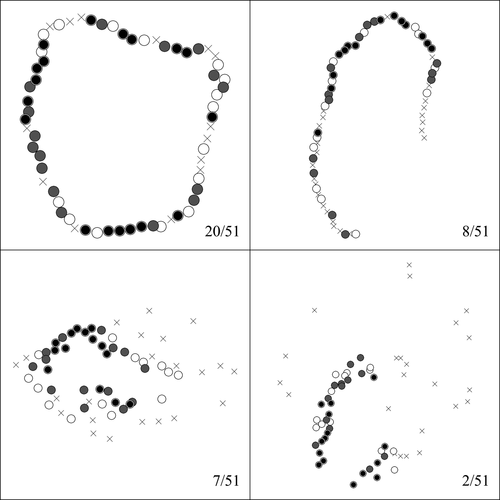
We can further observe, however, that these examples tend to be irregularly shaped, with better performance in those cases where higher use items are clustered along the surface. Outside of these cases, the usual character of configurations in Experiment 1 was considerably more dispersed. This, coupled with the finding of increased local usage density for high performance subjects, is at least consistent with multiple dispersed clusters (see, e.g., middle-right case in Fig. 3). In the future, targeted manipulations of item sequence statistics may better test these notions by more fully exploring the range of relevant set sizes, and the points of transition between single-surface, agent-interior organizations and dispersed multiple-surface, agent-exterior organizations.
4.3 Search and memory
Thus far, we have discussed organization primarily in terms of its influence in facilitating action (i.e., the sequential access of objects). However, it is important to note that efficient task performance depends not only on the ease of accessing items, but also on the ease of finding and identifying them. There are two basic mechanisms to make locating an item easier: (a) organize the space to facilitate search, and (b) obviate search by memorizing item locations. Very little work has explored the former aspect, though what has been done suggests that the factors that facilitate search dovetail with the factors that facilitate action. For example, Smilek, Weinheimer, Kwan, Reynolds, and Kingstone (2009) have shown that participants asked to arrange search items to make search easy tend to centralize targets, group similar items, and arrange distractors in regular arrays. Similarly, Anderson, Foulsham, Nasiopoulos, Chapman, and Kingstone (2014) report that individuals hiding an item for a friend (in contrast to hiding an item adversarially) tended to select a nearby, easy-to-reach location.
The use of memory in search has received considerably more attention (Võ & Wolfe, 2015), demonstrating robust memory for target locations when search is effortful (Solman & Kingstone, 2014; Solman & Smilek, 2012), when contextual semantic cues are limited (Võ & Wolfe, 2013), and in particular when targets have been actively searched for before (and not merely viewed incidentally; Draschkow, Wolfe, & Võ, 2014). These studies suggest that memory for item locations is probably quite strong in the current experiments, in particular for those items most frequently used.
Taken together, we suspect that the bulk of the organization in the present experiments was undertaken for the purposes of improving action, but with the necessary benefit of facilitating search. Organization for the sole purpose of facilitating search seems unlikely for two reasons. First, we find little evidence of display-wide organization into regular arrays that would facilitate search generally, with changes typically focused only on used items. Second, if changes were made solely to facilitate search, the prediction arises that the most robust organization should occur for those items used least often—as these are the least likely to have been memorized. Ultimately, search and access will always be tightly coupled, but in most naturalistic settings the use of memory is likely to dominate over exploratory search.
An important exception is raised for novel environments and novel tasks, where item locations are initially unknown. Here, the role of search behaviors may be quite critical in driving decision making, and in the ultimate shaping of the agent's biases. In a novel task, when there are two options available for action, the first to be located is almost certainly the one to be followed—and in so doing, to be reinforced through episodic memory. Indeed, in several measures we have shown that random biases in initial configurations were significant predictors of performance. The order and ease with which one first encounters items in a novel space is likely to have strong and lasting influences on subsequent decisions and behaviors. In this sense, differences in search strategies may have important implications for the earliest stages of engagement with a novel task.
4.4 Limitations
As a preliminary investigation of a relatively complex subject, it is important to examine the limitations and generalizability of the present work. First, we note that although the sequential associations between items in the present task were arbitrary, the stimuli used consisted of images of real, commonly used objects. Presumably, then, participants arrive at the task with substantial pre-existing biases with respect to how these objects are interrelated, and these biases could potentially interact with task demands to skew behavior in unanticipated ways. Any systemic influence of this kind was unlikely, as the specific items used and their inter-relations were randomized from subject to subject, but it is nonetheless possible that these prior associations could have disrupted the perception of groupings and relations in the task, and thereby attenuated organizational behaviors. Although the results from Experiment 2 make it clear that participants are able to identify and make use of arbitrary groupings, in the weaker task-structure of Experiment 1, prior experience could have played a larger role. In future, it may be of interest both to examine how organization unfolds with unfamiliar items, and to explicitly test how the identification of new relational groupings may be influenced by previously learned associations.
A related limitation concerns the manner in which the goal-spaces were structured, and consequently the sequential properties of item-associations. Our goal in the present work was to provide a relatively minimalist generalization of real-world behavior. Consequently, we focused only on implementing the sequential access and equifinality properties of naturalistic behavior. However, as discussed previously, item use in real settings typically involves more nuanced hierarchical relations, with significant variation among individual items in the extent to which they are recruited across multiple diverse tasks, or alternatively are used only in specific contexts. The two experiments in the present work demonstrate relatively extreme, and somewhat oppositional, task structures. In Experiment 1, item associations were uniformly random, with no explicit higher order organizational principles. Subsequences were idiosyncratic and rarely repeated. In Experiment 2, item associations were rigidly structured, with a given item either exclusively associated with a specific subset of other items, or else never associated with any item. Although measuring such extremes is a useful starting point for new investigations, it will be important in future work to incorporate more realistic demand-structures, based more closely on the organization of real-world task associations.
Similarly, we have used a very minimalist action space in the present work. Organization was limited to two dimensions (with stacking), item sizes were uniform, and there were no inherent constraints on movement through or use of the space. The present work investigates how order unfolds in the absence of constraint—as if one were working in a vast open field. We believe data from this unconstrained case provide a critical baseline, without which the interpretation of more complex spaces would be difficult. However, the bulk of routine human behavior unfolds in the context of considerable spatial constraints, including both “permanent” constraints like walls and doorways, as well as merely “stable” constraints emerging from the layout of furniture. As we have suggested in the previous discussion of task-space complementarity, much of the interest in the study of organization is likely to concern the interaction between spatial constraints and task constraints. To this end, having established some baseline properties of organization in unconstrained spaces, it will be necessary going forward to incrementally reintroduce constraints and natural partitions into the action space.
5 Conclusions
The majority of human behavior unfolds in built environments, where the individuals occupying the space largely determine the collection and arrangement of tools and resources. Differences in arrangement lead quite directly to differences in performance across tasks, by determining which items are most immediately “at hand” during execution or “at mind” during planning. Consequently, behaviors that modify these arrangements are of critical importance in shaping day-to-day activity. In order to study these organizational behaviors, we have introduced a novel task in which participants are given control over the configuration of their task environment. Although complex, and with many behavioral freedoms, results from these experiments show promising consistency and interpretability.
Our preliminary results indicate that subtle order emerges organically, simply through the constraints of embodied actions. Each time an item is accessed, it must afterwards be replaced in the world, and small asymmetries in these replacement decisions can lead, over time, to a rough partitioning of infrequently used items and frequently used items, which come to be relatively peripheralized and centralized, respectively (see also Agre, 1997). This form of gradual, emergent order arises even for randomly structured task demands, and it may provide a mechanism for describing the kinds of ordered clutter that permeate human spaces—arrangements which seem to embody neither complete disorder nor any sensible breed of categorization. In addition to this basic form of emergent order, and when task demands are more structured (as determined, for instance, by high community among subsets of items), much stronger organizational tendencies can be observed. When items are intrinsically partitioned by the task, they are likewise partitioned in space, made proximal even at the expense of overlap and reduced visibility. In the case of these more deliberate organizations, and in contrast to the subtler emergent order, individual differences in performance can be clearly tied to individual differences in organization.
Acknowledgments
This work was supported by an NSERC Discovery Grant to AK and by an NSERC Postdoctoral Fellowship and a Killam Trust Postdoctoral Research Fellowship to GJFS.



